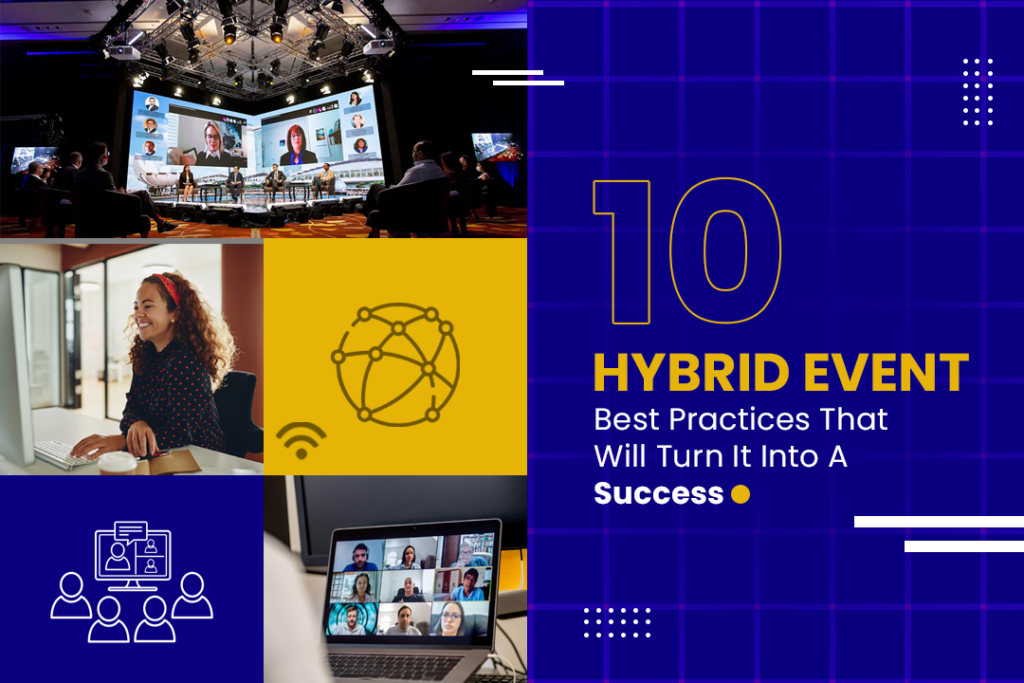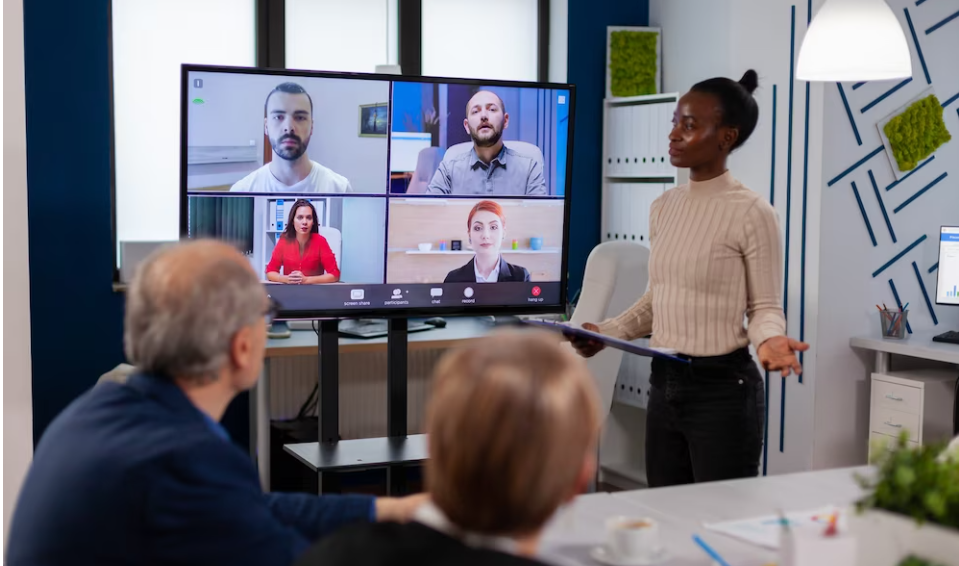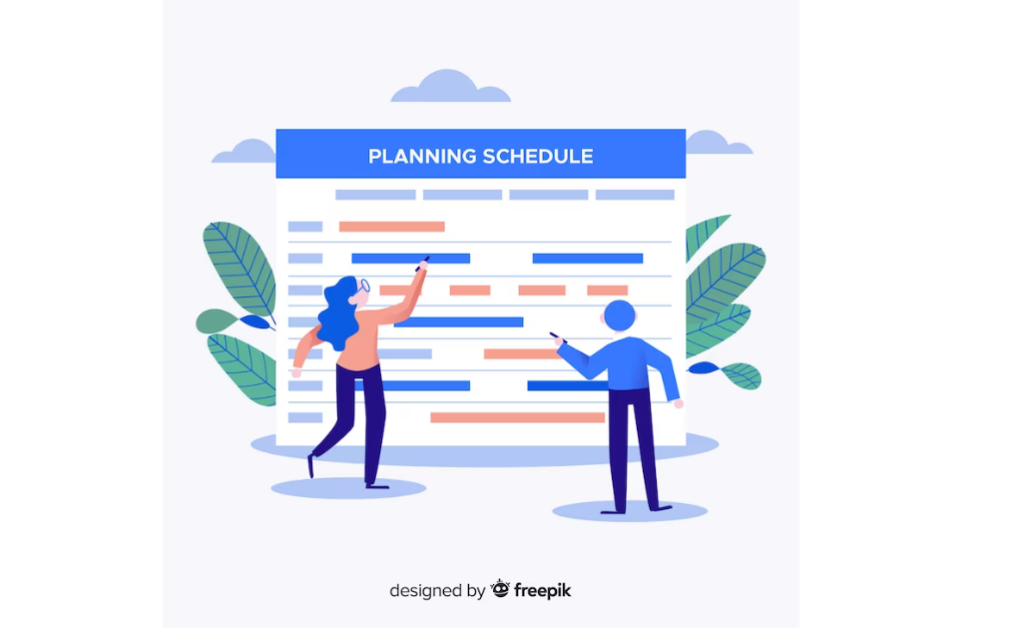
Hybrid events have emerged as a crucial link between the virtual and physical worlds, offering a unique opportunity to enhance attendance, broaden audiences, and host larger events. Understanding the concept of hybrid events and their operation is paramount if you aim to leverage their potential fully.
Planning and executing a successful hybrid event requires a comprehensive approach that caters to virtual and physical participants’ needs, keeping them engaged throughout the event. With the help of Eventible’s global conference participants’ feedback, we have identified ten hybrid event best practices for organizing a successful hybrid event that will help bridge the gap between event organizers and participants.
These practices encompass the entire event lifecycle, from pre-event planning to post-event follow-up, and are designed to deliver an immersive and engaging experience to all attendees.
What are Hybrid Events?

A hybrid event is a live structure that combines the finest features of in-person and online events. This method allows guests to experience your event in person or online. This enhanced adaptability enables a more extensive audience scale and reach. Hybrid events have additional advantages, including improved involvement and more extensive sponsorship options.
10 Hybrid Event Best Practices That Are A Must To Ensure Your Event’s Success
Hybrid Events allow attendees to participate in the event from the comfort of their homes or in person, depending on their preferences. To ensure that a hybrid event is a success, it’s essential to consider several critical factors, including:
1. Clearly Define your Objectives for the Event

Defining clear objectives is a crucial first step in planning a successful hybrid event. Objectives provide direction and focus, helping you to determine what you want to achieve with your event. When defining your objectives, consider the following questions:
- What is the purpose of your event?
- Who is your target audience, and what do you hope to achieve for them?
- What is the desired outcome or impact of your event?
- What are the key themes or topics that you want to cover during the event?
- What goals do you hope to achieve, such as increasing attendance, generating leads, or launching a new product?
Having clear and well-defined objectives will help guide your planning and ensure all event elements align with your goals. It will also help you stay focused and measure the event’s success.
2. Plan for a Seamless Event

Planning is a critical factor in the success of a hybrid event. The earlier you start planning, the more time you have to address potential challenges and ensure everything runs smoothly on the event day. Consider the following steps when preparing for hybrid conferences:
- Determine the event’s date and location, considering factors such as venue availability, speaker schedules, and the target audience’s availability.
- Develop a detailed budget, considering the costs associated with technology, equipment, and staffing.
- Choose a virtual platform that is reliable, user-friendly, and accessible for all attendees, and test it thoroughly before the event.
- Determine the content and format of the event, taking into account the interests and preferences of your potential in-person and online audience and the event’s goals.
- Identify potential speakers or presenters and secure their participation well in advance.
- Develop a comprehensive communication plan that includes the method and frequency of communication with attendees, speakers, and other stakeholders.
- Create a hybrid event checklist to ensure you don’t miss out on any aspect.
Planning and taking a proactive approach ensures that your hybrid event is well-organized, well-executed, and successful.
3. Invest in quality technology for the event

Technology plays a crucial role in the virtual aspect of the event, and it’s important to choose technology that is reliable, user-friendly, and accessible for all attendees. Consider the following when investing in technology for a hybrid event:
- Determine your technology needs based on the format and goals of your event. This may include a virtual platform for hosting the event and equipment for audio and video recording and streaming.
- Choose a reliable, easy-to-use, accessible virtual platform for all attendees, including those with disabilities.
- Invest in high-quality equipment, such as microphones, cameras, and lighting, to ensure the best possible audio and video quality.
- Test the technology thoroughly before the event to ensure everything runs smoothly on the day of the event.
- Consider hiring a professional to manage the technical aspects of the event, such as audio and video recording and streaming, to ensure that everything runs smoothly.
Investing in quality technology is an investment in the success of your hybrid event. Choosing reliable and user-friendly technology ensures your event is accessible and engaging for all attendees.
4. Promote the Event Effectively

Effective promotion is crucial for ensuring a successful hybrid event. It helps to build excitement and attract attendees, both in-person and virtual. Consider the following when promoting your hybrid event:
- Utilize multiple channels: Promote your event through various channels, including email, social media, and advertising. This helps reach a wider audience and increase visibility for the event.
- Partner with influencers and organizations: Partnering with influencers and organizations in your industry can help to increase visibility and attract more attendees to the event.
- Offer incentives: Consider offering incentives, such as discounts or special perks, to encourage attendees to register for the event.
- Provide clear and concise information: Ensure all promotional materials and communications are clear, concise, and easy to understand. Provide all relevant information about the event, including the date, time, location, and agenda.
- Build excitement: Use language and visuals that build excitement for the event and encourage attendees to participate.
- Create a sense of community: Encourage attendees to share their excitement for the event on social media and other channels. This can help to build a sense of community and create anticipation for the event.
Promoting the event effectively can increase visibility, attract attendees, and build excitement for your hybrid event. A well-promoted event is more likely to succeed in attendance and overall impact.
5. Engage Your Audience Throughout the Event

Encouraging active participation from attendees is essential for a successful hybrid event. Provide opportunities for interaction. It can be done in the ways mentioned below-
- Q&A sessions,
- Virtual networking opportunities and
- Break-out groups
Encourage attendees to participate by making it easy and accessible. Make sure the virtual platform is user-friendly and provides opportunities for interaction. Offer opportunities for virtual attendees to connect with in-person attendees, such as virtual breakout rooms or group activities.
Additionally, consider incorporating live music, keynote speakers, or other interactive activities to keep attendees engaged and entertained. Audience interaction can create a memorable experience and build a sense of community.
6. Provide Technical Support During the Event

Technical issues can be frustrating for attendees, and it’s essential to have a plan to resolve problems as quickly and efficiently as possible. Consider the following when providing technical support during a hybrid event:
- Establish a dedicated technical support team or designate a point person to handle technical issues during the event.
- Ensure all attendees know how to contact the technical support team in case of any issues. This could be through an email address, phone number, or chat function on the virtual platform.
- To minimize the number of technical issues that arise, provide clear and concise instructions for accessing and using the virtual platform.
- Have a plan to address common technical issues, such as connectivity problems or difficulty accessing the virtual platform.
- Provide on-site technical support to ensure attendees can access immediate assistance in case of any issues.
- Monitor the technical support channels during the event to ensure all issues are promptly addressed.
By providing technical support during a hybrid event, you can ensure that all attendees have a positive and seamless experience, regardless of any technical issues that may arise.
7. Consider Time Zones for Maximum Hybrid Participation

When planning a hybrid event, it’s essential to consider the time zones of your attendees. Time-zone differences can impact the event’s accessibility for virtual attendees and affect the overall event experience for in-person and virtual attendees. Here are some tips for considering time zones for your hybrid event:
- Determine your target audience: Consider the location of your target audience and the time zones they reside in when planning your event.
- Choose a convenient time for everyone: When choosing a date and time for your event, consider the time zone differences of both in-person and virtual attendees.
- Provide clear information: To ensure that attendees know the correct time, all promotional materials and communications should include clear information about the event’s date, time, and time zone.
- Offer multiple time options: To accommodate attendees in different time zones and increase accessibility, consider offering various time options for the event.
- Use technology to your advantage, such as time zone conversion tools and virtual meeting platforms. Ensure attendees can participate in the event from their preferred location, regardless of time zone.
By considering time zones for your hybrid event, you can increase accessibility and ensure that all attendees, regardless of location, can participate and have a positive experience.
8. Ensure accessibility to the attendees’

Accessibility refers to the design of products, devices, services, or environments so that people with disabilities can easily use them. When planning a hybrid event, it’s essential to consider the accessibility needs of all attendees, including those with disabilities. Here are some tips for making your event accessible:
- Provide closed captions or transcriptions: For virtual attendees, provide closed captions or transcriptions of all audio content during the event to ensure that those who are hard of hearing or deaf can fully participate and understand the content.
- Offer alternative formats: To accommodate attendees with visual impairments, provide alternative formats of event materials, such as large print or Braille.
- Consider the platform accessibility: Ensure that the virtual platform used for the event is accessible and meets the needs of all attendees, including those with disabilities.
- Provide accessibility support: Designate a team or individual responsible for supporting attendees with disabilities in person and virtually.
- Regularly test the accessibility: Regularly test the accessibility of the virtual platform and event materials to identify and address any issues before the event.
Event planners can create an inclusive environment that allows everyone to participate and enjoy the event by ensuring accessibility for all attendees.
9. Rehearse Before the Event

Rehearsing is an essential step in ensuring the success of a hybrid event. Rehearsals provide an opportunity to test the technology, iron out any kinks in the event’s flow and timing, and give speakers and presenters a chance to get comfortable with the virtual format. Consider the following when rehearsing for a hybrid event:
- Invite all speakers, presenters, and key stakeholders to participate in the rehearsal to ensure everyone is comfortable with the technology and the event’s format.
- Test the technology thoroughly during the rehearsal, paying close attention to the audio and video quality, as well as the timing and flow of the event.
- To avoid logistical challenges, rehearse the entire event, including introductions, presentations, and Q&A sessions.
- Pay close attention to the event’s timing and make any necessary adjustments to ensure the event runs on schedule.
- Encourage open communication during the rehearsal and solicit feedback from all participants to identify areas for improvement.
By rehearsing the event, you can ensure that everything runs smoothly on the day of the event and that all participants are comfortable with the technology and format. A successful rehearsal can lead to a successful event and ensure attendees have a positive and engaging experience.
10. Measure Success After the Event

To gather valuable insights into attendees’ experience and identify opportunities for improvement, it’s important to collect feedback through surveys, focus groups, or post-event evaluations.
Measuring a hybrid event’s success is crucial to evaluating its impact and determining areas for improvement. Various metrics can be used to measure the success of a hybrid event, including:
- Attendance: Track the number of in-person and virtual attendees and compare it to your goals.
- Engagement: Measure the level of engagement of attendees during the event, such as the number of questions asked, comments made, or interactive elements participated in.
- Feedback: Collect feedback from attendees through surveys, focus groups, or post-event evaluations to gather insights into their experience and identify areas for improvement.
- Return on Investment (ROI): Evaluate the costs associated with the event, such as technology, equipment, and staffing, and compare it to the revenue generated and the impact on your organization’s goals.
- Reach: Measure the reach of your event by tracking the number of views, impressions, or shares of virtual components, such as live streams or recorded sessions.
Using these metrics, you can understand your hybrid event’s success and make informed decisions about future events. Additionally, sharing the results of your evaluations with attendees, stakeholders, and partners can help build trust and demonstrate the value of your event.
Key Takeaway
Hybrid events are a distinctive and effective method of bringing virtual and in-person participants together. Using the abovementioned practices, you can design a successful hybrid event that engages participants, delights them, leads to the required results, and forges long-lasting relationships.
A well-thought-out and executed hybrid event will allow you to accomplish your goals and leave a positive impression. Whether you’re trying to raise brand recognition, generate leads, encourage community participation, or offer education and training. Additionally, you can visit Eventible and read some of our reviews to find out more about how attendees engage and what they anticipate from various event forms. You may then customize your experiences as a result. You can also choose the best events per your needs based on past reviews and ratings on our website- Eventible.




Comments are closed.